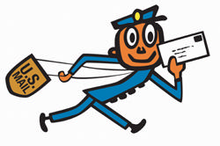In the annals of American postal history, one whimsical character stands out as an iconic symbol of postal efficiency and modernization: Mr. ZIP. Created in the early 1960s by the United States Postal Service (USPS), Mr. ZIP played a pivotal role in promoting the use of ZIP codes and reshaping the way we address our mail. This essay explores the fascinating history and enduring legacy of Mr. ZIP.
 The backdrop to Mr. ZIP’s creation was a nation experiencing profound demographic shifts and increasing urbanization. The United States was entering an era of rapid population growth and expanding metropolitan areas. With this growth came a dramatic increase in mail volume, straining the postal system’s ability to efficiently process and deliver mail. To address this challenge, the USPS introduced ZIP codes in July 1963. ZIP, which stands for “Zone Improvement Plan,” was a novel system designed to streamline the sorting and delivery of mail. It divided the country into zones, with each zone represented by a numerical code. The introduction of ZIP codes promised to significantly improve mail accuracy and speed.
The backdrop to Mr. ZIP’s creation was a nation experiencing profound demographic shifts and increasing urbanization. The United States was entering an era of rapid population growth and expanding metropolitan areas. With this growth came a dramatic increase in mail volume, straining the postal system’s ability to efficiently process and deliver mail. To address this challenge, the USPS introduced ZIP codes in July 1963. ZIP, which stands for “Zone Improvement Plan,” was a novel system designed to streamline the sorting and delivery of mail. It divided the country into zones, with each zone represented by a numerical code. The introduction of ZIP codes promised to significantly improve mail accuracy and speed.
To promote this revolutionary postal code system and educate the public about its advantages, the USPS enlisted the artistic talents of Howard Wilcox, a renowned graphic designer. Wilcox created Mr. ZIP, a charming cartoon mail carrier with a distinctive postal worker’s hat and the letters “ZIP” prominently emblazoned on his chest. This lovable character became the face of ZIP codes. Mr. ZIP took center stage in a comprehensive nationwide marketing campaign aimed at encouraging the use of ZIP codes. Posters, pamphlets, advertisements, and promotional materials featured the character, helping to drive home the importance of these new codes in mail delivery.
Mr. ZIP was not just a mascot; he was a postal educator. He appeared in instructional materials that provided guidance on how to use ZIP codes accurately. The campaign’s slogan, “Mail moves the country—ZIP codes move the mail,” underscored the role of ZIP codes in enhancing mail processing and reducing errors. Mr. ZIP’s campaign was an unqualified success. It effectively raised awareness about the benefits of ZIP codes and encouraged their adoption by the American public. Over time, the use of ZIP codes became standard practice in addressing mail. Mr. ZIP had transformed from a marketing tool to a symbol of postal modernization.
The story of Mr. ZIP is more than just the history of a cartoon character; it’s a tale of innovation and adaptation in the face of a changing world. Mr. ZIP helped bridge the gap between an antiquated postal system and a rapidly evolving society. His enduring legacy lies not only in the use of ZIP codes, which remain essential in the modern postal service, but also in his role as a charming ambassador who made postal modernization accessible and even fun.
In an age when efficiency and accuracy are paramount in mail delivery, we owe a debt of gratitude to Mr. ZIP, the mailman who taught us all how to “ZIP” our letters and packages, forever transforming the way we send and receive mail in the United States.